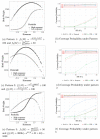This is a preprint.
Mediation Analysis using Semi-parametric Shape-Restricted Regression with Applications
- PMID: 38076520
- PMCID: PMC10705571
Mediation Analysis using Semi-parametric Shape-Restricted Regression with Applications
Update in
-
Mediation Analysis using Semi-parametric Shape-Restricted Regression with Applications.Sankhya Ser B. 2024 Nov;86(2):669-689. doi: 10.1007/s13571-024-00336-w. Epub 2024 Jul 2. Sankhya Ser B. 2024. PMID: 39633618 Free PMC article.
Abstract
Often linear regression is used to perform mediation analysis. However, in many instances, the underlying relationships may not be linear, as in the case of placentalfetal hormones and fetal development. Although, the exact functional form of the relationship may be unknown, one may hypothesize the general shape of the relationship. For these reasons, we develop a novel shape-restricted inference-based methodology for conducting mediation analysis. This work is motivated by an application in fetal endocrinology where researchers are interested in understanding the effects of pesticide application on birth weight, with human chorionic gonadotropin (hCG) as the mediator. We assume a practically plausible set of nonlinear effects of on the birth weight and a linear relationship between pesticide exposure and hCG, with both exposure-outcome and exposure-mediator models being linear in the confounding factors. Using the proposed methodology on a population-level prenatal screening program data, with hCG as the mediator, we discovered that, while the natural direct effects suggest a positive association between pesticide application and birth weight, the natural indirect effects were negative.
Keywords: Birth-weight; Constrained inference; Human chorionic gonadotropin (hCG); Mediation analysis; Pesticides exposure; Placental-fetal hormones; Regression spline; Shape-restricted inference.
Figures



References
-
- Adibi J. J., Layden A. J., Birru R. L., Miragaia A., Xun X., Smith M. C., Yin Q., Millenson M. E., O’Connor T. G., Barrett E. S., Snyder N. W., Peddada S., and Mitchell R. T.. First trimester mechanisms of gestational sac placental and foetal teratogenicity: a framework for birth cohort studies. Human reproduction update, 27(4):747–770, 2021a. - PMC - PubMed
-
- Barjaktarovic M., Korevaar T. I., Jaddoe V. W., de Rijke Y. B., Visser T. J., Peeters R. P., and Steegers E. A.. Human chorionic gonadotropin (hcg) concentrations during the late first trimester are associated with fetal growth in a fetal sex-specific manner. European journal of epidemiology, 32(2):135–144, 2017. - PMC - PubMed
-
- Barker D. J. P.. The developmental origins of adult disease. European Journal of Epidemiology, 18(8):733–736, 2003. - PubMed
Publication types
Grants and funding
LinkOut - more resources
Full Text Sources
